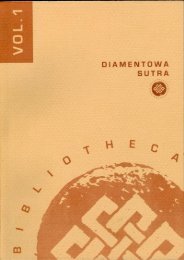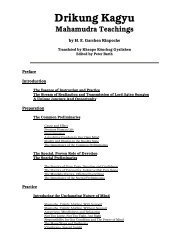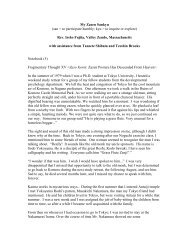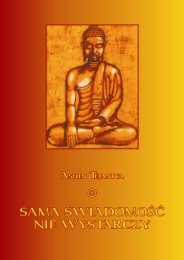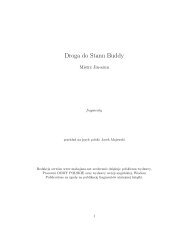3 - Computing in the Humanities and Social Sciences
3 - Computing in the Humanities and Social Sciences
3 - Computing in the Humanities and Social Sciences
You also want an ePaper? Increase the reach of your titles
YUMPU automatically turns print PDFs into web optimized ePapers that Google loves.
<strong>in</strong> <strong>the</strong> present body (sokush<strong>in</strong> jøbutsu), whereas <strong>the</strong> two dhåra√∆ of Amida become vocal<br />
<strong>and</strong> grammatological <strong>in</strong>scriptions of <strong>the</strong> process lead<strong>in</strong>g one to be reborn <strong>in</strong> Amida’s<br />
Pure L<strong>and</strong> (gokuraku jødo).<br />
We could say that <strong>the</strong> syntax of sh<strong>in</strong>gon <strong>and</strong> darani consists <strong>in</strong> a set of rules<br />
establish<strong>in</strong>g a sacred l<strong>in</strong>guistic space through <strong>the</strong> use of particular <strong>and</strong> fixed expressions,<br />
as well as a code associat<strong>in</strong>g by analogy a sequence of sounds to a meditative or<br />
salvational process. Sounds <strong>and</strong> <strong>the</strong> steps of soteriology are identified through <strong>the</strong><br />
mediation of <strong>the</strong>ir content that is attributed to <strong>the</strong> elements of <strong>the</strong> mantras. In this<br />
manner, it was (is) not impossible to create new mantras on <strong>the</strong> basis of a set of<br />
doctr<strong>in</strong>es, deities, <strong>and</strong> soteriological goals.<br />
Semantics<br />
Frits Staal drastically denies that mantras have a mean<strong>in</strong>g (Staal 1986, 1989). In <strong>the</strong><br />
case of sh<strong>in</strong>gon, however, each expression is endowed with a def<strong>in</strong>ite, albeit complex,<br />
mean<strong>in</strong>g. Accord<strong>in</strong>g to Hjelmslev, <strong>the</strong> two planes of a verbal language are not <strong>in</strong><br />
conformity, that is, <strong>the</strong>y are not <strong>in</strong> an isomorphic relation. In o<strong>the</strong>r words, <strong>the</strong><br />
correlation between units of <strong>the</strong> expression <strong>and</strong> units of <strong>the</strong> content that establishes <strong>the</strong><br />
sign is not term to term <strong>and</strong> is, <strong>in</strong> any case, arbitrary. Hjelmslev excludes from <strong>the</strong><br />
semiotic field those systems, known as monoplanary or symbolic, <strong>in</strong> which <strong>the</strong> form of<br />
<strong>the</strong> expression co<strong>in</strong>cides with <strong>the</strong> form of <strong>the</strong> content. (Hjelmslev 1943). Umberto Eco, <strong>in</strong><br />
contrast, argues that that which characterizes a semiotic system is not monoplanarity,<br />
but <strong>in</strong>terpretability (Eco 1975: 128-129). Now, mantras show many cases of conformity.<br />
A good example has been offered by Lopez, accord<strong>in</strong>g to whom <strong>the</strong> famous mantra that<br />
concludes <strong>the</strong> Heart Sutra (Sk. Prajñå påramitå h®daya s¥tra, Jp. Hannya haramitta sh<strong>in</strong>gyø,<br />
commonly known as Hannya sh<strong>in</strong>gyø, might constitute “an encoded summary of <strong>the</strong><br />
preced<strong>in</strong>g sutra” (Lopez 1990: 367). Lopez calls it “an allegory,” s<strong>in</strong>ce it “simulates <strong>the</strong><br />
path by provid<strong>in</strong>g an encoded narrative” (Ibid. 368). (For a detailed analysis of this<br />
sutra based on Tibetan commentaries, see also Lopez 1997). In rigorously Hjelmslevian<br />
terms, this is enough to deny <strong>the</strong>ir l<strong>in</strong>guisticity. Never<strong>the</strong>less, if we follow Eco, <strong>the</strong><br />
denial of l<strong>in</strong>guisticity does not affect <strong>the</strong>ir <strong>in</strong>terpretability <strong>and</strong> <strong>the</strong>refore <strong>the</strong>ir nature as a<br />
semiotic system.<br />
Pragmatics<br />
20



![Shushogi, Dogen Zenji [PDF] - Mahajana.net](https://img.yumpu.com/50921105/1/190x219/shushogi-dogen-zenji-pdf-mahajananet.jpg?quality=85)


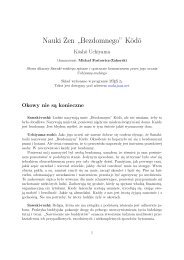

![wywiadu z Murakami Kosho Roshim [PDF] - Buddyzm w Polsce i na ...](https://img.yumpu.com/45809746/1/184x260/wywiadu-z-murakami-kosho-roshim-pdf-buddyzm-w-polsce-i-na-.jpg?quality=85)
